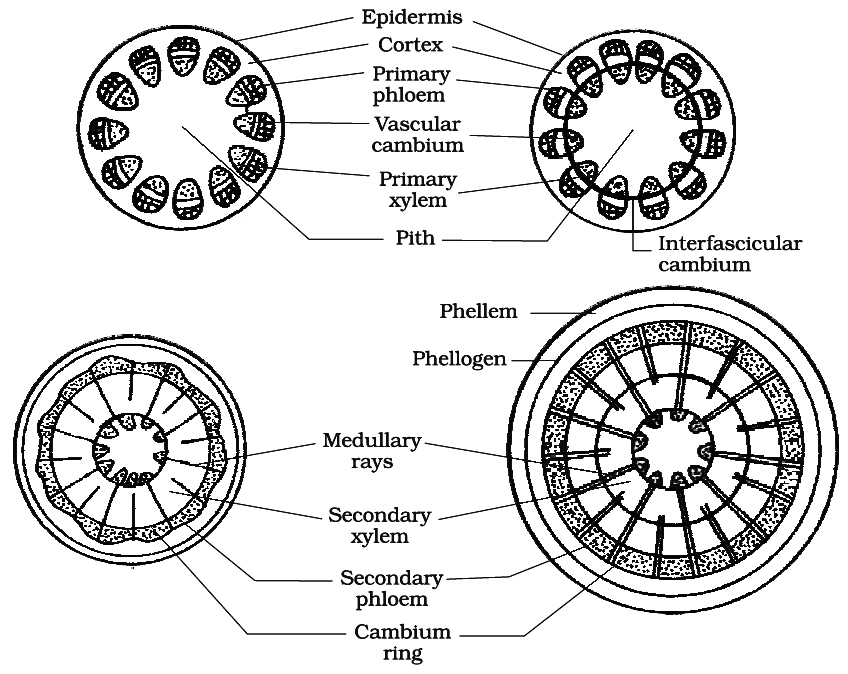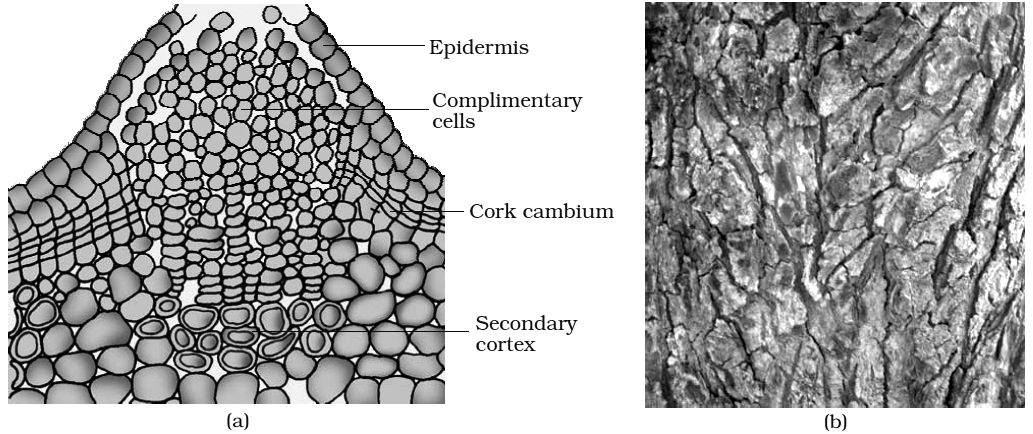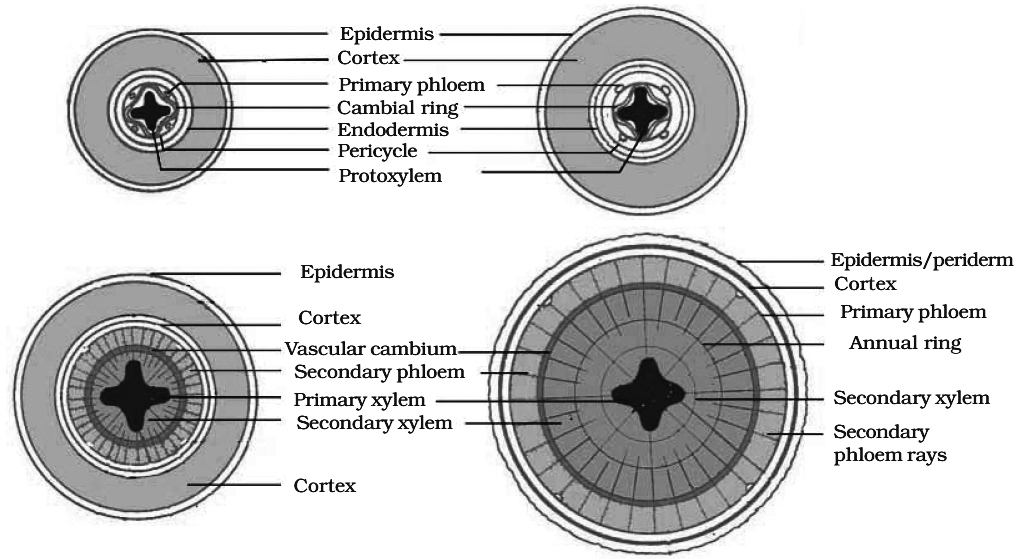- Books Name
- ACME SMART COACHING Biology Book
- Publication
- ACME SMART PUBLICATION
- Course
- CBSE Class 11
- Subject
- Biology
SECONDARY GROWTH
Increase in girth or thickness or diameter of the axis occurs due to formation of new tissues as a result of joint activity of vascular cambium and cork cambium in steler and extrasteler region respectively.
It occurs in the root and stem of gymnosperms and dicots.
Secondary growth in dicot stem completes in following steps :
A. Formation of vascular cambium ring :
(i) Intrafascicular cambium : It is primary in origin and is present between primary phloem and primary xylem.
(ii) Interfascicular cambium : It is true secondary meristem. It originates from parenchyma cells of medullary rays region. It lies in between the vascular bundles.
(iii) Vascular cambium ring: Both intrafascicular and interfascicular cambia join together and form a cambium ring.
Cells of cambium are of two types:
(a) Fusiform initials : They form tracheids, vessels, fibres and axial parenchyma in secondary xylem and sieve tubes, companion cells, fibres and axial parenchyma in secondary phloem.
(b) Ray initials : These are isodiametric and form ray parenchyma (vascular rays).
(iv) Periclinal division in cells of vascular cambium ring.
(v) Formation of secondary phloem (outside the vascular cambium) and secondary xylem (inner to vascular cambium). The amount of secondary xylem produced is 8-10 times greater than secondary phloem.
(vi) Due to formation of secondary phloem primary phloem is crushed to death, known as obliteration. Primary xylem being dead and lignified, persists in the pith region by replacing the pith cells.
(vii) At some places, the cambium forms a narrow band of parenchyma, which passes through the secondary xylem and the secondary phloem in the radial directions. These are the secondary medullary rays.
(viii) Formation of secondary structures i.e. annual rings, sapwood and heart wood, hardwood and softwood etc.

Different stages of secondary growth in a typical dicot stem
(a) Annual rings:
These are formed by the seasonal activity of vascular cambium.
Cambium is not uniformly active throughout the year.
In spring or summer cambium is more active and form large sized xylem elements (vessels) which constitute spring or early wood.
In Autumn or winter, cambium is less active and cuts off small sized xylem elements (vessels) and constitute autumn wood or late wood.
Both autumn and spring wood constitute a growth or annual ring.
In one year only one growth ring is formed.
In successive years numerous growth rings are formed.
Thus by counting the number of annual rings in the main stem at the base we can determine the age of a tree.
This branch of science is known as dendrochronology.
Concept Builder
Growth rings are distinct or sharply demarcated in the plants of temperate climate e.g., Shimla, Nainital, Mussourie due to presence of contrasting seasonal variations.
Growth rings are not distinct or sharply demarcated in the trees of tropical climate (near equator) e.g., Calcutta, Bombay, Madras due to absence of contrasting seasonal variations.
(b) Heart wood and sap wood:
The young elements of secondary xylem in the peripheral region constitute sap wood or alburnum.
It is light in colour and physiologically active.
The water conduction takes place through sap wood.
Sap wood is converted into heart wood or duramen in the central region.
It is dark in colour due to deposition of tannins, gums, resins and is physiologically inactive (almost dead) and provides only mechanical support.
During the conversion of sap wood into heartwood, the most important change is development of tyloses in the heart wood.
Tyloses are balloon like structures in lumen of vessels, developing from xylem parenchyma.
These tyloses block the passage of xylem vessels and are also called tracheal plug.
The heart wood is commercially used as wood.
When the plant is made hollow, it will not die because the water conduction takes place through sap wood.
The heart wood is well developed in Morus alba (Mulberry).
The heart wood is absent in Populus and Salix plant.
The wood of Tectona grandis is termite resistant.
As a tree grows older thickness of heartwood increases and sap wood remains same.
Heart wood is much more durable and resistant to microorganisms, insects and pests etc. than sap wood.
Concept Builder
Wood of dicot trees is called porous or hard wood because it consists of vessels (pores).
The wood of gymnosperms does not contain vessels (pores) and is known as soft or non porous wood.
Such wood consists of 90 to 95% tracheids and 5 to 10% of ray cells.
Sap wood will decay faster if exposed freely to the air.
On the basis of distribution and size of vessels, porous wood is of two types:
(a) Diffuse porous wood (primitive) : Vessels of same size are uniformly distributed throughout the growth, e.g., Pyrus, Betula.
(b) Ring porous wood (advanced) : Large vessels are formed in early wood when the need of water is great and small vessels are formed in late wood, e.g., Quercus, Morus.
B. Formation of cork cambium:
Cork cambium or phellogen develops from outer layer of cortex.
It produces secondary cortex or phelloderm on innerside and cork or phellem on outer side.
The cells of phellem are dead, suberized and impervious to water.
Cork cells are airtight and used as bottle stopper or cork.
The bottle cork is prepared from the cork of Quercus suber (Oak tree).
Cells of phelloderm are thin walled, living and store food. Phellem, phellogen and phelloderm are collectively called periderm.
Periderm is secondary protective tissue.
Due to pressure of secondary tissues, epidermis ruptures and cortex is largely lost after two or three years of secondary growth.
In the cork layer the lenticels are present which are meant for gaseous exchange.
In cork, lenticels have loosely arranged cells called complementary cells with intercellular spaces.
For bottle corks the cork, is processed in such manner, so that lenticels come in vertical direction.

Bark is a non-technical term for all the dead and living tissues outside the vascular cambium. Bark formed early in the season is called soft or early bark. Towards the end of the season late or hard bark is formed.
Concept Builder
(i) Scaly bark: Develops in strips e.g., Acacia, Psidium.
(ii) Ring bark: Develops in the form of sheet or ring, e.g., Betula (Bhojpatra).
The outermost layer of bark is dead and called as rhytidome.
The bark of Betula was being used as substitute of paper in ancient time to write manuscript.
Secondary Growth in Dicot Root
Vascular bundles in dicot root are radial, exarch and mostly triarch.
Vascular cambium is formed secondarily from conjuctive parenchyma cells lying just below each phloem strand.
Thus, the number of cambium strips formed equals the number of phloem strands.
The cells of pericycle lying outside the protoxylem also become meristematic to form part of strips of cambium.
These cambial strips join the first formed cambium strips to form complete, but wavy ring of vascular cambium.
This cambium ring produces secondary xylem on inner side and secondary phloem on outer side.
In roots, the growth rings are not distinct because there is no seasonal variation under the soil.
From the outer layers of pericycle arises the phellogen which cuts phellem (cork) on the outer side and secondary cortex or phelloderm toward the inner side.

Diagrams showing secondary growth in dicot root
Concept Builder
(i) Dicots with scattered vascular bundles in stem, e.g., Podophyllum, Peperomia, Piper, Papaver.
(ii) Cortical vascular bundles, e.g., Nyctanthus, Kalanchoe, Casuarina.
(iii) Medullary bundles, e.g.; Mirabilis, Bougainvillea, Amaranthus, Achyranthus.
(iv) Polystelic condition, e.g., Primula, Dianthera
(v) Anomalous or abnormal secondary growth occurs in Bougainvillea, Boerhaavia, Chenopodium, Aristolochia.
(vi) Some monocots show abnormal secondary growth by meristematic tissue which develops around vascular bundles, e,g., Dracaena, Yucca, Agave .
(vii) Virgin cork is first formed periderm.
(viii) Wound cork: It is secondary meristem; formed below injured area. It forms cork on outer side and callus below; which heals the wound.
(ix) Abnormal secondary growth in dicot root occurs in Beet root (Beta vulgaris) and Sweet potato (Ipomoea batatas) by the formation of numerous accessory rings of cambium which cut more storage parenchyma in secondary phloem and less secondary xylem.
(x) Homoxylous wood-wood of vesselless dicots, e.g., Ranales (Winteraceae, Tetracentraceae, Trochodendraceae) .
(xi) Heteroxylous wood is wood of vessel bearing dicots.
(xii) Polyderm is a special type of protective tissue occurs in roots and underground stems of members of Rosaceae and Myrtaceae. Its outermost layer is dead and suberized.
Summary
Anatomically, a plant is made of different kinds of tissues. The plant tissues are broadly classified into meristematic (apical, lateral and intercalary) and permanent (simple and complex).
Assimilation of food and its storage, transportation of water, minerals and photosynthates, and mechanical support are the main functions of tissues.
There are three types of tissue systems -epidermal, ground and vascular.
The epidermal tissue systems are made of epidermal cells, stomata and the epidermal appendages.
The ground tissue system forms the main bulk of the plant. It is divided into three zones cortex, pericycle and pith.
The vascular tissue system is formed by the xylem and phloem,
On the basis of presence of cambium, location of xylem and phloem, the vascular bundles are of different types. The vascular bundles form the conducting tissue and trans locate water, minerals and food material.
Monocotyledonous and dicotyledonous plants show marked variation in their internal structures. They differ in type, number and location of vascular, bundles.
The secondary growth occurs in most 6fthe dicotyledonous roots and stems and it increases the girth (diameter) of the organs by the activity of the vascular cambium and the cork cambium.
The wood is actually a secondary xylem. There are different types of wood on the basis of their composition ,and time of production.

 Maria Habib
Maria Habib
